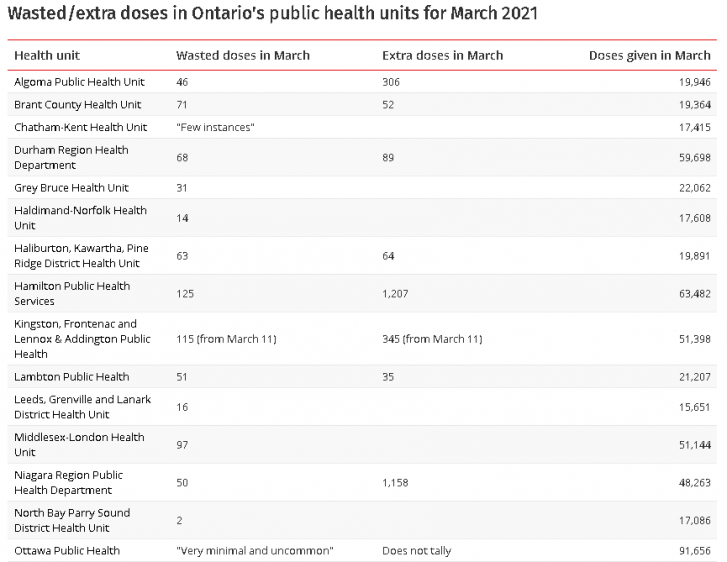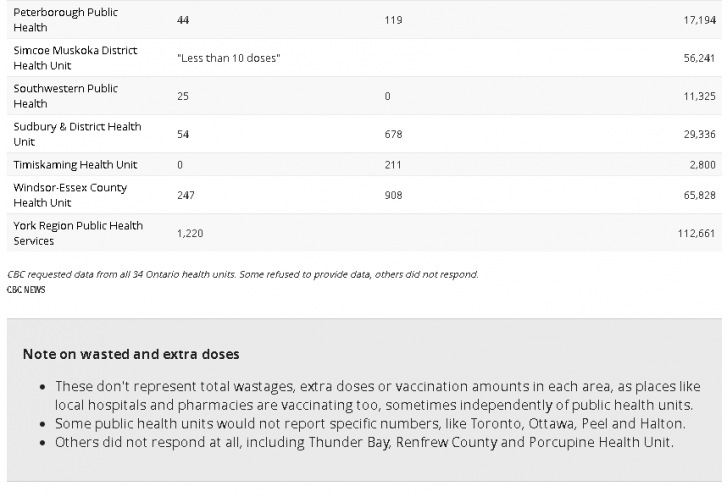Most health units wasted doses, but say they also pulled dozens of extra shots from vials
Most of Ontario’s public health units wasted dozens of COVID-19 vaccine doses last month. One wasted hundreds. But they argue that’s not the full story.
CBC News contacted all 34 Ontario public health units to ask how many, and why, doses were wasted in March as vaccination capacity ramped up significantly.
While wastages happen, health units say they also pull extra doses from vials, which they didn’t expect to have. That helps make up for doses they don’t use.
Wastages are a mix of manufacturer, equipment and human error. This includes cracked vials, particulate in vials and needle and syringe malfunctions. Clinic staff have dropped syringes on the ground, while patients have moved during injections and messed them up.
Some health units report having vaccine doses expire. Once you puncture a vial, you have six hours to use all its doses. Only one health unit explicitly said it wasted vaccines because it had trouble finding people to immunize.
The most common example across health units was not being able to pull the last dose from the vial. Vaccine companies allocate a certain number of doses per vial. If you can’t get all of them, it’s considered waste. Leftovers can’t be mixed in different vials.
Dr. Rosana Salvaterra, Peterborough’s medical officer of health, blames this on manufacturers. Her health unit reported 44 wasted doses in March of the 17,194 shots it administered.
“Some vials have a little more. Some vials have less,” she said. “You need really good eyesight because you are extracting such small amounts of vaccine into the syringes and you need good manual dexterity.”
She said some older physicians have opted out of helping with syringes because their eyes are going. Her health unit has been training newly graduated nursing students to help.


Extra doses make up for waste
The amount of extra doses pulled from vials ranges wildly between health units.
Hamilton wasted 125 doses in March, but pulled 1,207 extras of the 63,482 shots it administered. In the Haliburton, Kawartha, Pine Ridge District Health Unit, 63 doses were wasted compared to 64 extra doses pulled. The unit gave 19,891 shots in total.
“It’s an incomplete and inaccurate picture to report only wasted doses,” said Suzette Taggart, of the Kingston, Frontenac and Lennox & Addington Public Health (KFLA), in an email. “We draw extra doses more often than we waste doses so our net difference is positive, not negative.”
Indeed, KFLA wasted 115 doses from March 11 to early April, but had 345 extra doses in the same time frame. It gave 51,398 shots in March.
The head of York Region Public Health Services, which reported 1,220 wastages in March, the most of the public health units that responded to CBC News, isn’t too worried either — calling it “not true wastage.”
“In the grand scheme of things, the actual numbers of doses [wasted] are quite small relative to the number of doses that we administer,” said Dr. Karim Kurji, York’s medical officer of health.
Ontario’s ministry of health has set a maximum vaccine wastage rate at no more than five per cent of the vaccines over a 12-month period.
‘Every dose is precious’
Health units say they have learned a great deal and adjusted procedures. They will only thaw and prep enough vaccine for appointments that have been booked.
The province also requires they have plans in place in case there are cancellations, no-shows or extra vaccines left at the end of the day. This includes standby waiting lists for priority populations who can get to vaccination sites on short notice.
York Region reports the vast majority of its wastage comes from the inability to draw that pesky final dose. It’s learned longer, skinnier syringes (1 cc) are better at drawing the final dose than shorter, wider syringes. But it is having trouble acquiring them.
“We’re trying so hard to get that last drop out of the vial,” said Ann Ciniglio, a public health nurse with York managing a vaccine clinic.
“I see the people that are trying to get appointments. They are high risk groups. They’re essential workers … We’re not able to potentially draw out extra doses that could have more people coming.”
Ciniglio says she knows many people are working hard to acquire more of these syringes.
With all the demand, Salvaterra and her team are trying their best to minimize wastages and maximize extra doses.
“These vaccines are worth their weight in gold,” she said. “Every dose is precious.”
Article From: CBC
Author: Haydn Watters

